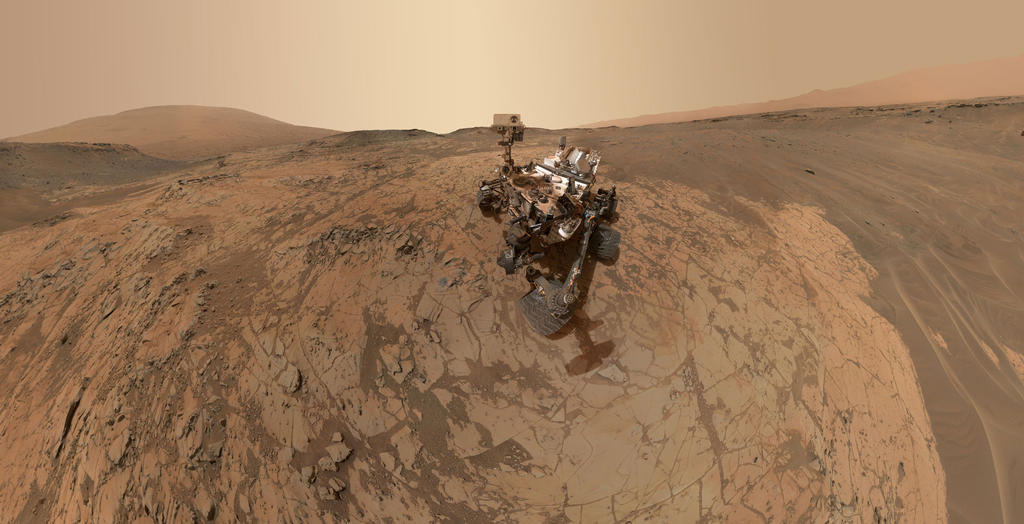 |
| Curiosity rover's self-portrait on Mars |
Over the past few weeks, the recurring theme of science and
art as overlapping disciplines has become more and more apparent with all the
new forms of technological collaboration from neuroscience and nanotechnology to
biotechnology and space. Many areas including biomedical engineering,
artificial intelligence and practically every other field within science and
technology have advanced enough to explore areas far beyond the comprehensible
boundaries of Earth. All while advancements in art have seemingly leveled off
in comparison. So is art actually getting closer to science as we have
attempted to cover throughout this quarter?
In my opinion, the answer is yes. While scientists endeavor
to understand the intricacies of the world’s structure and explore spaces never
traveled to by humanity, artists are seeking to expose the deeper implications
of such scientific advancements. From this perspective, art is not only growing
closer to science, but is also complementary and essential to the growth of
science. Just as Buckminster Fuller once said, “the further art advances the
closer it approaches science, the further science advances the closer it
approaches art” (Vesna).
"The Jetsons: Little Bundle of Trouble"
In addition to the previously studied focuses of science,
space science is a field that has made great strides over the past hundred
years. The space race between the US and USSR during the Cold War, mankind’s
first steps on the moon, and the landing of the Curiosity rover on Mars have
all sparked the imagination of the public and inspired artists to write about
the future. Pop culture shows such as “The Jetsons” and “Star Trek” influence
the way we imagine space and the future of our world to involve
extraterrestrial beings, flying cars and robots with artificial intelligence.
With much of the general populace indifferent to space exploration, space art
in its many forms plays an extremely important role in generating broader
interest towards the field across the board.
 |
| "First Steps" Mitchell Jamieson, 1963 |
"The astronomical artist will always be far ahead of the explorer. They can depict scenes that no human eye will ever see, because of their danger, or their remoteness in time and space"
-Arthur C. Clarke (NASA).
A clear example of space art is the NASA Art Program which
was started in 1962. The program was founded as an effort to “present NASA’s
discoveries and cutting-edge research to the public in a way that would be more
accessible than complex scientific reports” (NASA). This program allowed
artists to create depictions of NASA’s landmark achievements.
Works Cited:
"Curiosity Self-Portrait at 'Mojave' on Mount Sharp." Nasa.gov. NASA, 24 Feb. 2015. Web. 28 May 2015. <http://mars.nasa.gov/msl/multimedia/images/?ImageID=6976>.
"The Daily Galaxy." The Daily Galaxy. The Daily Galaxy, 23 Oct. 2013. Web. 28 May 2015. <http://www.dailygalaxy.com/my_weblog/2013/10/unknown-forces-causing-milky-way-galaxy-to-wobble.html>.
Dunbar, Brian. "The NASA Art Program." NASA.gov. NASA, 12 Apr. 2013. Web. 28 May 2015. <http://www.nasa.gov/connect/artspace/creative_works/feature-inception.html>.
Dunbar, Brian. "NASA Art Space." NASA.gov. NASA, 29 Nov. 2012. Web. 28 May 2015. <http://www.nasa.gov/connect/artspace/galleries/art_program/ArtProgramGallery.html>.
"The Jetsons: Little Bundle of Trouble." YouTube. YouTube, 12 May 2015. Web. 28 May 2015. <https://www.youtube.com/watch?v=CS8GRm2XTck>.
Vesna, Victoria. "Introduction to Buckminster Fuller." Bfi.org. Buckminster Fuller Institute, n.d. Web. 28 May 2015. <https://bfi.org/about-fuller/biography/introduction-buckminster-fuller>.
No comments:
Post a Comment